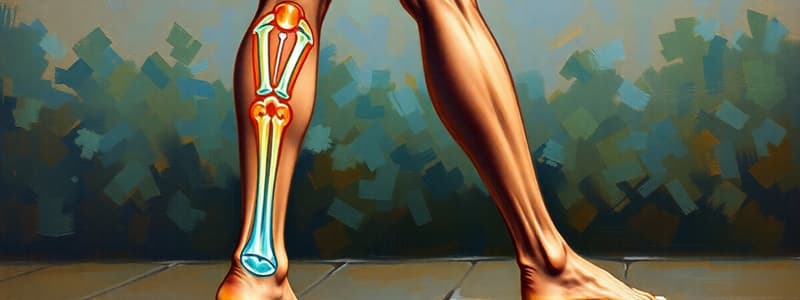Podcast
Questions and Answers
What is the primary effect of weak dorsiflexors during the gait cycle?
What is the primary effect of weak dorsiflexors during the gait cycle?
- No effect on gait
- Altered stance phase (correct)
- Increased speed
- Increased swing duration
Spastic plantarflexors do not affect the stance phase of the gait cycle.
Spastic plantarflexors do not affect the stance phase of the gait cycle.
False (B)
Name one compensatory mechanism associated with spastic plantarflexors.
Name one compensatory mechanism associated with spastic plantarflexors.
Increased knee flexion.
Weak dorsiflexors primarily affect the __________ phase of walking.
Weak dorsiflexors primarily affect the __________ phase of walking.
Match the type of impairment with its corresponding effect on the gait cycle:
Match the type of impairment with its corresponding effect on the gait cycle:
Which phase is directly affected by spastic plantarflexors?
Which phase is directly affected by spastic plantarflexors?
Weak dorsiflexors lead to a smoother gait cycle.
Weak dorsiflexors lead to a smoother gait cycle.
List two potential overall effects on gait due to impairments at the ankle.
List two potential overall effects on gait due to impairments at the ankle.
What effect does weak quadriceps have during the swing phase of the gait cycle?
What effect does weak quadriceps have during the swing phase of the gait cycle?
Short hip flexors have no effect on the stance phase of the gait cycle.
Short hip flexors have no effect on the stance phase of the gait cycle.
What is the primary effect of weak hamstrings during the stance phase of the gait cycle?
What is the primary effect of weak hamstrings during the stance phase of the gait cycle?
Weak hip extensors primarily affect the __________ phase of the gait cycle.
Weak hip extensors primarily affect the __________ phase of the gait cycle.
Which impairment affects the knee during the stance phase with a likelihood of knee buckling?
Which impairment affects the knee during the stance phase with a likelihood of knee buckling?
Weak hamstrings have no effect on the swing phase of the gait cycle.
Weak hamstrings have no effect on the swing phase of the gait cycle.
What impact do short hip flexors have on gait?
What impact do short hip flexors have on gait?
Impairments at the knee can be caused by weak __________.
Impairments at the knee can be caused by weak __________.
What is a consequence of weak hip extensors during the gait cycle?
What is a consequence of weak hip extensors during the gait cycle?
Flashcards
Weak Dorsiflexors in Stance
Weak Dorsiflexors in Stance
Weak dorsiflexors during the stance phase of gait result in insufficient foot elevation, potentially leading to foot drop.
Weak Dorsiflexors in Swing
Weak Dorsiflexors in Swing
Weak dorsiflexors in the swing phase can also cause tripping or foot dragging.
Spastic Plantarflexors in Stance
Spastic Plantarflexors in Stance
Spastic plantarflexors during stance cause excessive foot plantarflexion during gait.
Spastic Plantarflexors in Swing
Spastic Plantarflexors in Swing
Signup and view all the flashcards
Associated Compensations (Spastic Plantarflexors)
Associated Compensations (Spastic Plantarflexors)
Signup and view all the flashcards
Overall Gait Effects
Overall Gait Effects
Signup and view all the flashcards
Weak Quadriceps
Weak Quadriceps
Signup and view all the flashcards
Weak Hamstrings
Weak Hamstrings
Signup and view all the flashcards
Short Hip Flexors
Short Hip Flexors
Signup and view all the flashcards
Weak Hip Extensors
Weak Hip Extensors
Signup and view all the flashcards
Study Notes
Ankle Impairments
-
Weak Dorsiflexors:
- Initial Contact: Difficulty controlling ankle dorsiflexion eccentrically when the foot hits the ground; leads to slapping of the foot.
- Loading Response: Reduced shock absorption, instability, over-reliance on hip/knee extensors for forward momentum.
- Swing: Reduced forward propulsion, foot dragging, compensation through hip hiking and increased knee and hip flexion.
-
Spastic Plantarflexors:
- Initial Contact: Difficulty with initial contact, leading to a toe-first landing and poor shock absorption .
- Push-off: Insufficient push-off, likely due to stiffness in the plantar flexors.
- Swing: Toe dragging preventing effective foot lifting, compensation involving hip hiking, increased knee flexion, and circumduction.
- Associated Compensations: Knee hyperextension, excessive trunk lean (for stability), reduced step length, gait asymmetry, and slower walking speed
-
Weak Quadriceps:
- Initial Contact: Reduced knee stability, preventing proper eccentric control.
Knee Impairments
- Weak Quadriceps:
- Initial Contact: Reduced knee stability, impeding eccentric control.
Hip Impairments
-
Short Hip Flexors:
- Stance: Reduced hip extension, compensation through excessive lumbar lordosis, and trunk leaning.
- Swing: Inefficient propulsion in the swing phase, compensations by excessive knee flexion and pelvic rotation.
- Early Heel Rise: Exaggerated anterior pelvic tilt and short step length
-
Weak Hip Extensors:
- Stance: Difficulty controlling trunk stability, resulting in backward trunk lean during initial contact and forward trunk lean during midstance.
- Poor Pelvic Stability: Leading to forward trunk lean.
-
Reduced Hip Extension:
- Swing: Delayed or ineffective transition into swing phase, increased hamstring usage for deceleration, and instability at initial contact
Studying That Suits You
Use AI to generate personalized quizzes and flashcards to suit your learning preferences.




